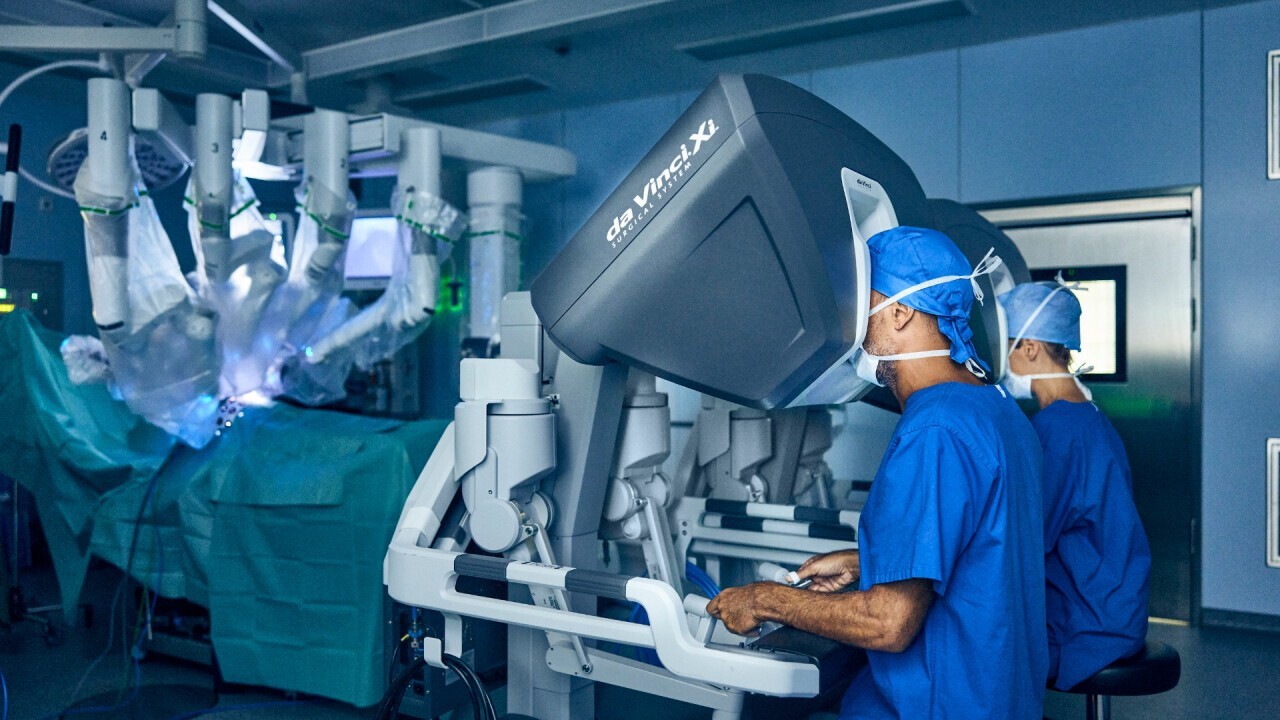Operating theatre as digital control room: AI-supported robotics in surgery
Surgery is undergoing a transformation: tireless robots have already made themselves indispensable in many operating theatres. Now artificial intelligence is being added - adaptive, predictive and precise. In future, humans, machines and algorithms will work together as a team in the operating theat
Where previously the surgeon's skill and experience alone were decisive, machines are now involved - controlled by humans but increasingly thinking along with them. The operating theatre is developing into a digital high-performance centre in which algorithms analyse images in real time, recognise the finest tissue structures and support surgical decisions with high precision.
Technological development is coming up against a healthcare system under pressure. Staff shortages and increasing numbers of interventions call for solutions that improve efficiency and quality in equal measure. Robotic assistance systems offer concrete advantages here. Studies show that interventions with their support lead to lower complication rates, less post-operative pain and shorter hospital stays. In an analysis of knee operations, for example, the revision rate was significantly reduced. AI-supported robotics will unfold its potential in minimally invasive surgery in particular: It promises a new dimension of surgical precision and safety - for doctors and patients alike.
Robots don't get tired
Professor Alexander König, interim chair for Robotics and Systems Intelligence at the Technical University of Munich, has been studying the interaction between humans and machines for many years. He is convinced: "Automated assistance systems can increase patient safety. This is because they must be approved before they can be used on patients - in Europe through CE labelling, in the USA through the FDA. These processes place high demands on hardware, software and processes. Such systems are reliable and do not act unexpectedly - and they do not get tired. This can increase quality and safety, even if they cannot replace the best surgeon."

Alexander König, Technische Universität München ©Alexander König
Robotic assistance systems do not operate autonomously, but support doctors in performing surgical procedures actively or semi-actively. While semi-active systems are used in minimally invasive surgery in particular, active systems are primarily used in orthopaedics or neurosurgery. They not only perform movements, but also navigation, imaging and the precise placement of instruments - without any tremors.
AI learns from previous interventions
Artificial intelligence goes one step further: it analyses, learns and interprets. In surgery, this means that software based on machine learning or deep learning recognises images, plans movements and prepares decisions. The difference to traditional robotics lies in its adaptability: the systems react to new situations, learn from past interventions and constantly optimise themselves.
Systems such as ‘da Vinci’, ‘Versius’ and ‘Hugo RAS’ have become established in modern operating theatres. These robotic assistants not only provide a stable hand but are increasingly being combined with intelligent software. The interface between man and machine is becoming a command centre where doctors no longer cut directly, but control, monitor and make decisions.
Dynamic interaction
AI algorithms are used in several areas. They identify organs and vessels on camera images, calculate the optimal incision line or analyse vital parameters in real time. The systems learn to recognise critical situations and issue warnings in good time. This creates a dynamic interaction: the technology observes, analyses and provides information - the human decides.
"Artificial intelligence is currently used in the medical technology market primarily in image analysis - for example in X-ray, ultrasound or MRI scans. It performs an initial screening, recognises possible abnormalities and provides information that can then be used as a basis for further work - for example, in the control of a robot," explains Axel Weber, Vice President Medical Robotics at KUKA.

Axel Weber, KUKA ©KUKA Group
KUKA, one of the world's leading suppliers of intelligent automation, has been contributing its industrial experience to medical technology for a quarter of a century. The company does not develop complete surgical systems, but provides robotic platforms such as the LBR Med, which are integrated into clinical solutions by partners. The focus here is on flexible, collaborative systems that can be safely integrated into sensitive everyday clinical practice. These systems unfold their potential particularly in combination with AI.
New dimension of care
In neurosurgery and orthopaedics, too, technology is providing millimetre precision: drilling holes in the skull or spine can be carried out with robotic precision, while AI systems constantly analyse data and suggest corrections. In turn, a new dimension of care is opening in emergency medicine and telesurgery: technology is making expertise mobile and usable regardless of location.
"We are developing a technical demonstrator for telesurgery. Currently, the doctor and patient are always in the same room, connected by a cable. But with decreasing care density - especially in rural areas - this will not be enough. We will then need systems that allow doctors to treat patients tactilely, i.e. with haptic feedback - even over long distances," explains Alexander König.
On the way to personalised surgery
AI-supported robotics can make surgical procedures more reproducible and safer. Technological progress also offers economic potential. Shorter waiting times, fewer follow-up operations, more efficient operating theatre procedures and better use of resources reduce the burden on the system. Finally, AI paves the way for personalised surgery: in future, algorithms could calculate individual surgical plans based on medical history and imaging - a digital assistant that makes medical action more precise without replacing it.
Widespread implementation is only just beginning. "Many people have a robot hoover at home that works well. But semi-autonomous robotic solutions - whether in medicine or production - are not yet where we would like them to be. At the same time, we are seeing a strong increase in interest from investors. You can get very far with 10 per cent of the funding, but the last 10 per cent to market maturity requires enormous financial resources - and this is precisely where many are currently struggling," emphasises König.
Technical challenges and ethical questions
However, any progress also brings with it questions. From a technical perspective, the processing of large amounts of data in real time poses a particular challenge. Image data, sensor data, movement analyses - everything has to be captured, interpreted and implemented at lightning speed. Added to this is the complexity of the systems: many components must work together seamlessly; interfaces are often missing, and standards have not yet been established.
Some legal and ethical issues also remain unresolved. Who is liable if an AI system makes an incorrect recommendation? How transparent must its processes be? The so-called ‘black box’ problem presents doctors and developers with new responsibilities. And the question of accessibility is also central: Sophisticated technology must not become the privilege of a few but must be open to all patients.
Shared autonomy
"I don't think it's realistic to expect AI to perform fully autonomous operations in the near future. Although the first medical decision-making systems have been approved, we are still a long way off in embodied AI - in other words, when robots physically interact with the world," König categorises. "A major research topic is therefore 'shared autonomy', in which AI and humans work hand in hand."
"Medical technology is very conservative - we are still a long way from fully autonomous systems," Axel Weber also believes. "But we shouldn't underestimate the opportunities that additional autonomy and robotics offer. AI in particular can make a huge contribution to reducing the workload, for example in the documentation of treatments - even if this is not directly related to robotics."
‘Explainable AI’
Research in the field of AI-supported robotics is currently experiencing a phase of intense dynamism. Interdisciplinary teams around the world are working on making surgical systems more intelligent, safer and more transparent. The focus is on so-called ‘Explainable AI’ models - in other words, artificial intelligence whose decision-making paths are not hidden, but are comprehensible. This is because trust is crucial, particularly in a medical context: a technology whose recommendations cannot be explained quickly reaches the limits of acceptance.
Alexander König emphasises: "Technical progress is being made at ever shorter intervals. But just because something is technically feasible does not mean that it is also useful or economical. An innovation must always have a commercial benefit."
Relief in the face of a shortage of skilled labour
At the same time, the development of self-learning systems is moving into focus. They analyse data from past operations, recognise patterns in complications and refine their assistance functions on this basis. The aim is to improve surgical decision support - a dynamic learning system that becomes more precise with each new operation. Several pilot projects are currently investigating how such systems can generate specific recommendations for action in real time without restricting the surgeon's room for manoeuvre.
Axel Weber emphasises how important the interaction between the clinic and technology is: "The more complex a situation is, the more intelligent the AI needs to be. But we can see how quickly it learns. This should be seen as an opportunity - robotics can relieve the burden in many areas. The shortage of skilled workers clearly shows that there is a lack of people, from nursing to highly specialised surgery."
Investment backlog in hospitals
Development is being supported by national and international programmes. In Germany, university hospitals are working on trialling AI-based navigation aids in liver surgery or automated tissue analysis in laparoscopic oncology. At the same time, a growing number of start-ups are bringing fresh impetus to the market: their modular platform solutions enable the gradual integration of intelligent functions into existing robotic systems - a decisive step towards making the technology accessible to smaller hospitals.
At the same time, investment financing by the federal states in Germany is often considered inadequate. According to the German Medical Technology Association (BVMed), the investment backlog in German hospitals amounts to around 50 billion euros. For innovative technologies such as robotic assistance systems to become widely available, clear strategies are needed - technically, financially and legally.
"We are only at the beginning of a development that will accelerate significantly over the next few years," says König. "What is still being tested in the laboratory today could be part of everyday clinical practice tomorrow - provided we ensure quality and acceptance in equal measure."
Remote-controlled operations
A look into the future shows: The operating theatre could become a digital control room in which man and machine work in close symbiosis. Traditional surgical planning will be replaced by an adaptive system that combines pre-operative image data, real-time sensor data and patient-specific histories to generate dynamic intervention strategies. Interventions would no longer be prepared statically but would be continuously accompanied and optimised by AI.
AI systems could, for example, recognise whether an operation is going according to plan or whether an unexpected complication is developing - and suggest surgical alternatives based on this. Remote control of operations is also becoming increasingly important: AI-supported analyses and precise robotic execution will make it possible to plan and perform operations from any location in the future. This offers a new dimension in medical care, particularly in structurally weak regions or in disaster scenarios.
Expertise requirements are increasing
"It will be crucial that we don't just think about the systems in technical terms," warns König. "We also need to keep an eye on the effects on roles, competences and responsibilities - otherwise we risk being overburdened instead of relieved."
In the long term, the role of surgeons will change. They will become coordinators of a highly complex system in which decisions are made by humans but are increasingly prepared based on data. This will increase the demands on training and digital expertise - not only in dealing with technology, but also in critically scrutinising algorithmic suggestions. At the same time, the regulatory framework will also have to evolve: Authorisation procedures, data protection rules and liability issues are facing fundamental readjustments.
Axel Weber summarises: "Change will not come in leaps and bounds, but gradually. But we have to set the course today so that safe, integrated and patient-centred systems become a reality tomorrow."
MedtecLIVE Health Pavilion promotes the transfer
From 24 to 27 June 2025, MedtecLIVE's Healthtech Pavilion at the renowned trade fair duo automatica and Laser World of Photonics in Munich will provide a platform for all those who are helping to shape this transformation. The joint stand acts as an industry vertical for medical technology - where developers and suppliers meet a target group focussing on automation, robotics and photonics. It will be complemented by Bayern Innovativ's ‘MedtecSUMMIT meets automatica’ on 25 and 26 June.
"With MedtecLIVE, we are covering the entire value chain in medical technology manufacturing. With the Healthtech Pavilion, MedtecLIVE is now bringing a contact point for information from manufacturers and service providers in the medical technology supply sector to Munich", says Silke Ludwig, Deputy Director MedtecLIVE. "The focus here is on solutions in the fields of automation, robotics and photonics - future technologies that ultimately lead to more efficient and reliable processes in everyday clinical practice."

Silke Ludwig, MedtecLIVE © NürnbergMesse
Customised formats for the medical technology sector
MedtecLIVE is the leading trade fair in Europe for the development and manufacture of medical technology. It is part of a Brand Family that offers the industry more than just a trade fair and supports it in advancing medical technology with its wide range of products and services as well as its strong network and partners. This creates several platforms at Stuttgart, Nuremberg and Munich, where the most diverse players in the industry can meet their target group in a customised way.


